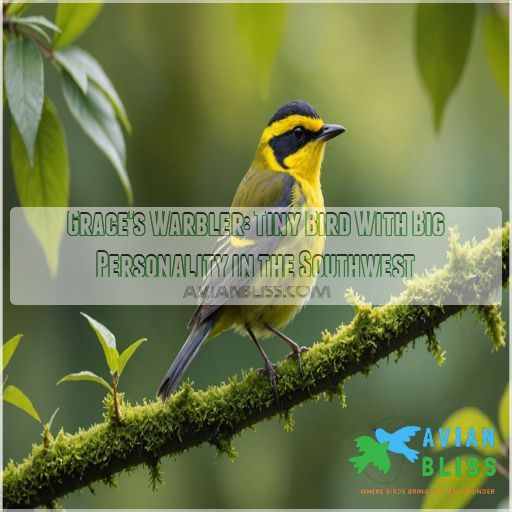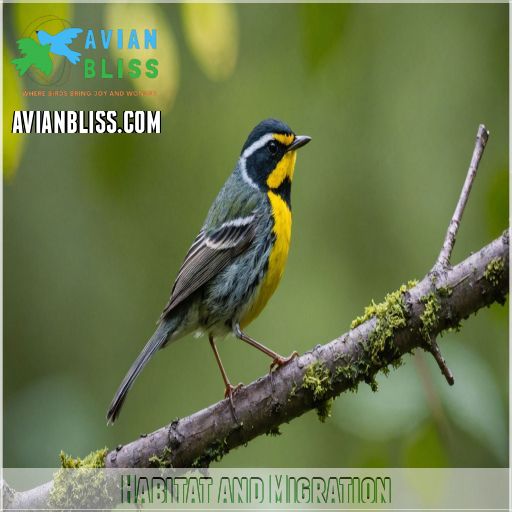This site is supported by our readers. We may earn a commission, at no cost to you, if you purchase through links.
 If you’re drawn to the vibrant tapestry of Southwest birdlife, Grace’s Warbler is your quirky little artist in the forest canopy.
If you’re drawn to the vibrant tapestry of Southwest birdlife, Grace’s Warbler is your quirky little artist in the forest canopy.
With its lively yellow eyebrow and a flair of gray and white plumage, this bird might just outshine any fashionista.
Small yet fierce, it summers in the Southwest, munching on insects with a gusto that would make any gourmet proud before migrating to Mexico’s pine-oak forests.
Despite a stable population of three million, this warbler faces hurdles like habitat loss and climate change.
Ready to learn more about the life of a bird that’s small in stature, big in personality?
Table Of Contents
Key Takeaways
- grace’s warbler is a pint-sized dynamo, sporting eye-catching yellow, gray, and white plumage that outshines even the most stylish dresser in the forest canopy. Keep an eye out for its distinctive yellow eyebrow while it energetically munches on insects.
- These lively birds don’t just hang around; they have a high-energy lifestyle filled with daring mid-air foraging and singing elaborate mating songs. Their social lives are like a reality show of feathers, complete with territorial disputes and nurturing parenting.
- During migration, Grace’s Warblers are like globetrotters, journeying from the Southwest to Mexico’s pine-oak forests, occasionally making surprise appearances in California. Their journey is a testament to their resilience, though climate change and habitat loss are ominous clouds on their horizon.
- Conservation efforts are a lifeline for these birds. Joining citizen science projects or advocating for their habitats https://avianbliss.com/black-throated-green-warbler/ helps ensure these vibrant warblers continue to paint the skies, bringing flashes of yellow brilliance to the forests where they thrive.
Physical Characteristics
The Grace’s Warbler may be small, but it packs a big punch with its striking gray, white, and yellow plumage.
At just 4 1/2 to 5 inches long, this petite bird is easily mistaken for similar species, so pay close attention to its distinctive features like the short, thin beak and bright yellow eyebrow like the Pyrrhuloxia.
Plumage and Coloration
Grace’s Warbler, always charming with its vibrant plumage patterns, flaunts bright colors that make birdwatchers swoon, a testament to the diverse colors found in nature a result of evolutionary pressures.
Its gray above and white below feathers provide a classic contrast, accented by a cheerful yellow throat and eyebrow.
As molting cycles and seasonal changes influence, this little warbler dons its signature look, creating a visual melody that enchants the soul.
Size and Weight
Warblers might seem tiny, with an average weight less than a ping-pong ball, but they’ve got big personalities.
- Size Comparison: 4 1/2 to 5 inches long.
- Weight Variation: Little flutterers weigh 7-9 grams.
- Sexual Dimorphism: Females, you guessed it, are slightly smaller.
- Weight by Age: Lightweight champions at any stage!
Beak Shape and Size
You might think size isn’t everything, but for Grace’s Warbler, a short, slender beak is a masterpiece of evolutionary significance.
It’s designed for precision in catching insects mid-air, reflecting its foraging techniques.
Like a tiny pair of tweezers, its beak adaptations match perfectly with food preferences, making it a real snack connoisseur in its mountain forest home.
Similar Species
While the Grace’s Warbler is a distinctive bird, it can be easily confused with the similar-looking Yellow-rumped Warbler. The key differences lie in the Grace’s more vibrant yellow throat and eyebrow, as well as its preference for pine-oak forests over the Yellow-rumped’s more varied habitat. Listen closely for the Grace’s thin, rising chatter versus the Yellow-rumped’s buzzy call.
Habitat and Migration
You’ll often find Grace’s Warbler enjoying its summer in the Southwest’s mountain forests, tweeting away high up in pine trees.
Grace’s Warbler is often found in the Southwest’s mountain forests during the summer.
Just when you’re thinking they’re settling down, they’re off on their migratory journey to Mexico, occasionally popping up unexpectedly in California like a surprise visit from an old friend.
Summer Residency in the Southwest
Grace’s Warbler really turns the Southwest into its summer paradise, arriving in April like a feathered friend visiting its favorite vacation spot.
This tiny songbird spends its summer in the high pine trees, where the view must be spectacular!
In the Southwest, you might spot these warblers amidst:
- Mountain forests
- Pine trees
- Breeding season activities
- Threats like habitat loss
Migration Patterns
Observing Grace’s Warbler on its migration journey offers a glimpse into avian determination.
These small birds take flight in April, covering impressive distances to reach their summer homes in the Southwest.
Altitude and weather pose migration challenges, but they navigate with precision.
Migration research highlights their adaptability, an impressive feat given their tiny size, showcasing nature’s resilience.
Wintering Grounds in Mexico
During the winter months, Grace’s Warblers head south to the pine-oak forests of Mexico’s mountains, where they can be found foraging high in the canopy for insects.
This wintering habitat, however, faces threats from deforestation and climate change, which could impact the warbler’s survival and population numbers in the long run.
Rare Autumn Strays to California
In California, you might spot these feathery adventurers known for their unpredictable journeys. Imagine the warbler as a tiny explorer gone rogue:
- They stray west on rare occasions.
- Their unpredictable migration patterns create excitement.
- California sightings are an ornithologist’s jackpot.
- Conservation concerns arise with habitat shifts.
Think of them as the Marco Polos of the bird world!
Behavior and Diet
Get ready to explore the lively behavior and unique diet of Grace’s Warbler, which spends its days energetically darting through treetops for tasty insects.
You might find it amusing how these feathered acrobats deftly patrol their territory, showing off their tiny but mighty personalities.
Foraging Habits
Picture Grace’s Warbler, a feathered aerial acrobat performing its delightful foraging techniques high in the treetops. It weaves through branches, darting mid-air for tasty treats. Humorously competitive, it often clashes with fellow birds in its quest.
As each season shifts, the warbler’s prey selection adjusts, guided by habitat influences. Variety, indeed, spices up this bird’s life!
| Technique | Advantage | Challenges |
|---|---|---|
| Darting Flights | Quick Catch | Predation Risk |
| Branch-Hopping | Stealthy Approach | Energy-Intensive |
| Hovering | Precision Targeting | Time-Consuming |
Insectivorous Diet
You’d be forgiven for thinking this tiny warbler subsists on a diet of birdseed and nectar, but Grace’s Warblers are actually insect connoisseurs.
They dine on a diverse menu, including:
- Caterpillars and other soft-bodied insects
- Spiders and other arachnids
- Beetles and other hard-shelled bugs
- Flying insects snatched mid-air
This varied diet fuels their high-energy lifestyle, darting through the treetops in search of their next tasty morsel.
Breeding and Territorial Behavior
Grace’s Warbler can be quite the busybody when setting up home and heart. With nest site selection as careful as choosing your next favorite hangout spot, mates exchange calls in elaborate mating rituals.
Picture territorial defense like holding a "Keep Out" sign.
Their efforts boost nesting success, ensuring two broods per year.
Watch out for brood parasites!
| Behavior | Description |
|---|---|
| Nesting Success | Two broods annually |
| Mating Rituals | Elaborate call exchanges |
| Territorial Defense | "Keep Out" behavior |
| Brood Parasitism | Watchfulness necessary |
Social Structure
Grace’s Warblers, with their dynamic social structures, often surprise observers:
- Male-female relationships balance care and responsibility.
- Flocking behavior supports survival in tight-knit groups.
- Territorial defense showcases their bold, unwavering spirit.
- Social hierarchy sets their pecking order, though it’s less about power, more about cooperation.
Their social interactions are intricate, yet interesting, like a reality show with feathers!
Breeding and Nesting
You’ll be amazed at how Grace’s Warbler pairs up and settles down, using their high-altitude nest-building skills to create cozy cradles for the next generation.
From picking just the right tree-level real estate to singing duets with their feathered mates, these tiny architects manage their families with precision and grace.
Mating and Courtship
As the breeding season approaches, you’ll witness the Grace’s Warbler’s engaging courtship rituals.
Males stake out prime territories, singing their thin, rising chatter to attract mates.
They may even perform aerial displays, fluttering and diving to impress potential partners.
This lively dance is a delightful glimpse into the private lives of these tiny, charismatic birds.
Nest Construction and Placement
When crafting its cozy home, this warbler opts for pine trees, placing nests 20–60 feet high. The female uses fibers, oak catkins, and down, lining it with feathers for comfort. Though nest predators lurk, they persevere.
- Nest materials: Fibers, catkins, webs.
- Nest height: 20-60 feet above ground.
- Nest success: A delicate balance against nature’s challenges.
Egg Characteristics and Incubation
Let’s explore the charming mysteries of the warbler’s eggs.
Eggs are creamy white, adorned with brown spots clustering at one end.
A typical clutch size ranges from three to four eggs.
While the incubation period and specific incubation behaviors remain largely unknown, intriguing anecdotes suggest a magical hatching success rate that keeps bird enthusiasts on their toes with curiosity and wonder.
Parenting and Fledging
Moving from incubation, parenting takes center stage.
You might imagine the thrill of watching the fuzzball nestlings grow.
A parent’s job includes:
- Feeding Behavior: Constant trips to gather juicy insects.
- Fledgling Independence: Teetering first flights teach balance.
- Fledgling Success: Songs for the road ahead, chirps of encouragement.
Encourage and empower them; they’ll start soaring soon enough!
Conservation Status and Threats
The Grace’s Warbler may face some challenges, but conservation efforts are underway to protect this charismatic little bird.
While its overall population is stable, habitat loss and climate change could threaten the warbler’s future in the Southwest.
Population Estimates and Trends
Grace’s Warbler, boasting a stable population of 3 million, seems to breeze through the skies with resilience.
However, it isn’t all sunshine and rainbows; climate change effects and habitat impact are storm clouds on the horizon.
Conservation efforts focus on ensuring this tiny bird continues to charm treetops and serenades us, inspiring hope for a bright future outlook.
Habitat Loss and Fragmentation
With a population that’s holding steady, habitat loss and fragmentation still loom large over Grace’s Warbler.
Imagine seeing their mountain forests diminish due to:
- Forest fragmentation
- Land use change
- Human impact
- Sustainable forestry
But, there’s hope! Embracing habitat restoration can give these spirited warblers the vibrant homes they deserve. Let’s keep their adventurous spirit soaring high!
Climate Change Impacts and Vulnerability
Climate change adaptation is crucial for Grace’s Warbler, whose range shifts make it vulnerable. Imagine a bird trying to swap its summer wardrobe for winter duds too early! Habitat loss exacerbates their plight, impacting species interactions. To keep these beauties singing, conservation strategies must tackle climate threats and guarantee their home doesn’t become a birdy ghost town.
Conservation Efforts and Research
While climate change poses a serious threat to the Grace’s Warbler, conservation efforts are underway to protect this charismatic bird.
You can get involved by participating in citizen science projects, supporting habitat restoration initiatives, and advocating for conservation partnerships.
With your help, we can make sure this species continues to thrive in the Southwest for generations to come.
Frequently Asked Questions (FAQs)
What is the Graces Warblers lifespan?
The lifespan of the Grace’s Warbler isn’t well documented, but it’s estimated they can live 5-7 years in the wild. (Source)
Though small, these resilient birds thrive in their pine forest habitats if we protect them.
How do Graces Warblers communicate socially?
Picture a maestro leading an orchestra; Grace’s Warblers communicate with melodious thin rising chatters.
Males protect their territory with song, adding a bit of musical flair to their social structure.
Their soft chip calls invite friendly responses.
Are there notable predators of Graces Warbler?
Grace’s Warblers, living life on the edge in treetops, face some natural enemies.
Raptors like hawks might swoop in as predators.
Despite this, they’ve crafted a life of nimble foraging and vibrant survival high in the pines.
Does Graces Warbler engage in any migratory rituals?
Think of it as nature’s grand ballet.
No specific migratory rituals are known for these birds, but you’ll often find them joining a feathered freeway in the sky as they gracefully migrate to their wintering grounds.
How is climate change specifically impacting their habitat?
Climate change is shrinking the Grace’s Warbler’s mountain forest habitat, forcing them to seek new homes.
You can help by supporting conservation efforts that protect these birds’ sensitive ecosystems.
Their future depends on it!
Conclusion
Grace’s Warbler is a pint-sized powerhouse, a delightful feathered dynamo painting the Southwestern skies with charm.
You’ll marvel at its plucky spirit as it navigates through life’s challenges like habitat loss and climate change.
With its exquisite plumage and bold personality, Grace’s Warbler isn’t just any bird—it’s a character you can’t ignore.
Protecting such a magnificent creature makes sure future generations can also enjoy its unique quirks and vibrant presence, making your role in conservation important.








